Eagle viewscreen
This Eagle viewscreen is used in The A B Chrysalis, Seed Of Destruction, Space Warp, The Bringers Of Wonder part 2, The Seance Spectre and Devil's Planet.


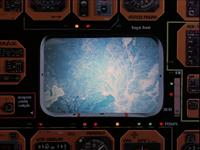
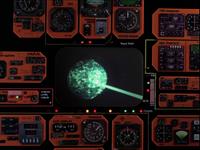
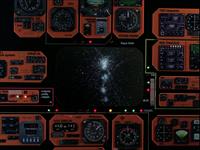

It largely replaced the triangular window seen in Year One, which may have been in poor repair after 3 years of filming. A simple rectangle would have been easier to mask the camera to film the special effects seen on the "screen".
It is presumably positioned between the two forward windows. This art by Robero Baldassari shows how the front of the pilot cabin might look. In The A B Chrysalis when the Eagle descends in the alien lift shaft, the Alphans watch the screen on the passenger module bulkhead (although when we see the bulkhead alongside the actors it has a normal viewscreen with no instruments around it).
The location of the instruments is not very practical- to operate any of the switches, the pilots would have to stand up and reach over their consoles.
The prop is a wooden panel that was created and filmed on the SFX stages at Bray Studios (it was never in front of the actors, who were at Pinewood). The front of the prop is painted black, with octagonal pieces of orange perspex. The orange panels are decorated with the photos of real aircraft instrument and Letraset (the Letraset brand name and copyright text is used for small text). On the back is written "14 volt". There are six small rear-facing light bulbs.
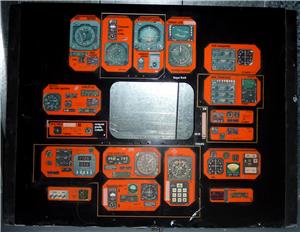
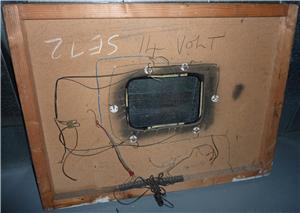
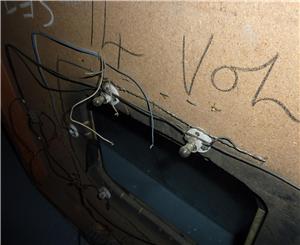
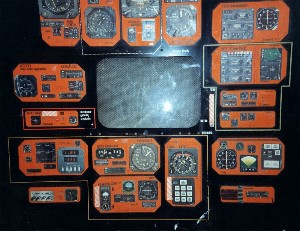
All the panels are real aircraft instruments. They are life-sized photos cut from aircraft instrument catalogues. The catalogues are from Sperry Flight Systems (now Honeywell Aerospace), King Radio (now Bendix/King by Honeywell) and Narco Avionics. They are state of the art 1970s-era analogue controls. Most are still in use today, and are little changed, but since the 1990s aircraft controls have increasing moved to LCD screens (so called "glass cockpits").
The Eagle has many duplicate instruments. This is not unrealistic for some of them. The numerous heading indicators are wildly contradictory (some say the craft is flying North, some South, some South-East; one altimeter says the craft is on the ground, the other says it is at 12700 feet). It is lacking some common instruments, including any vertical speed indicator (VSI).
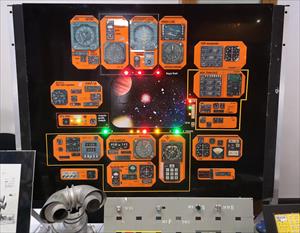
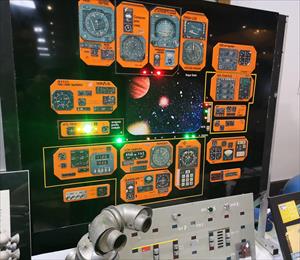
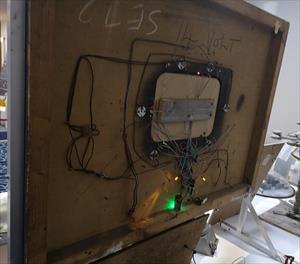
The prop at the London: 2024 convention, now fitted with lights.
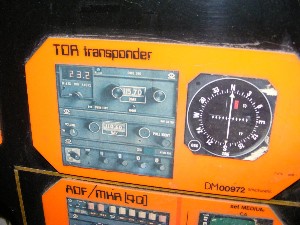
Top right is the "TOR transponder". A transponder is a Transmitter-responder, often a device that receives a signal and transmits an automatic response. All aircraft have transponders which are used by air traffic secondary radar - it sends an interrogation signal, and the aircraft transponder receives it and replies with the aircraft identification or altitude.
It actually includes a Narco DME 190, which is, in reality, a transponder. This DME (Distance Measuring Equipment) is tuned to receive on 115.70Mhz and transmit on 110.60Mhz (you can see the frequencies on the panel). All aircraft have a 4 digit octal number transponder code - this Eagle's identification is "1200", at the bottom of the panel. The mode switch alongside the code is set to "ALT"- which responds to identification and altitude secondary radar signals- the other modes (Off, Test, Standby) should obviously not be used in flight, although On may be used when (barometric) altitude signals are unreliable. The "IDENT" button above sends a "squawk" pulse in the signal, so the traffic controller sees the signal flash on his screen. At the top the DME shows the exact position from a ground station which is 23.2 miles (you can also set to show minutes or knots). The Narco DME 190, introduced in 1975, was the first totally solid state DME, and is still in use today.
The King Course Deviation Indicator (CDI) alongside the DME is set with 360 degrees (North) at the primary index, the needle is centred and the To/From indicator is showing "TO". The radial is indicating that the aircraft is on the 360 degree course (North) to the ground station (this means the aircraft is South of the ground station).

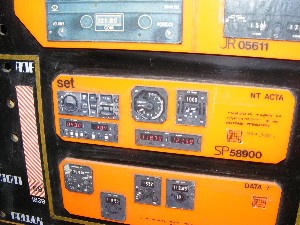
On the right of the screen we have the Narco CP 125 TSO radio, with both communications (COM) and navigation (NAV) and airborne automatic direction finder (ADF) channels. These are commercial aircraft frequencies (VHF), not military (which uses UHF). The panel of King instruments on right includes a KMA 20 TSO audio panel and a King weather radar indicator. There's also most of a Letraset International copyright notice.

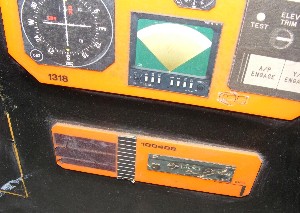
Bottom right we have two more King Course Deviation Indicator (CDI) dials again set to 360 degree North station, two radio-magnetic indicator (RMI) dials and a KWX 60 TSO weather radar. In the two RMIs, the thin needle points to an automatic direction finder (ADF) beacon and the thick double-barred needle points to a VHF omnidirectional radio range (VOR) beacon (typically DME stations are also VOR stations). There is also an autopilot test panel.
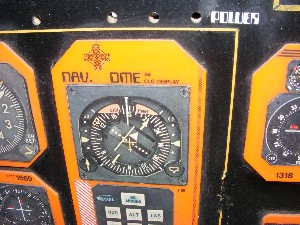
At the bottom under the viewscreen is the NAV. DME panel. The dial is a horizontal situation indicator (HSI), an instrument that combines a directional gyro (DG) and a Course Deviation Indicator (CDI). Note the aircraft symbol in the centre, and unlike the other CDIs this one is heading South according to the compass rose. Note the course selector is set to 210 degrees, a little to the west of where we're going. Below it is a Sperry Stars Flight Director (Stars stands for Sperry Three Axis Reference system) computer controller. The first auto-pilots, enabling a pilot to set the plane to fly straight ahead without touching the controls, were invented by Sperry in 1912, and in the 1960s the Sperry Stars flight directors introduced computer control to aircraft.
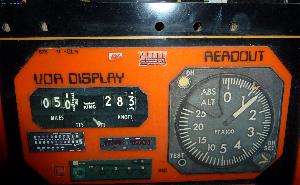
Bottom right under the viewscreen is this "VOR display / Readout" panel. The absolute altitude dial under the "Readout" label shows 1300ft (396m). The "VOR display" is actually a DME (Distance Measuring Equipment) rather than a VOR (VHF omnidirectional radio range beacon). It shows 50 miles to the DME ground station (which will probably also be a VOR beacon). The craft is travelling at 283 knots (146 metres per second). The DME is set to RTS mode (Request to Send) rather than TTS (Time to Station). At the bottom a Narco AT-50A Transponder shows the Eagle's ident to be 1200 (the same as the Narco DME 190 on the "TOR Responder" panel on the top right of the viewscreen panel).
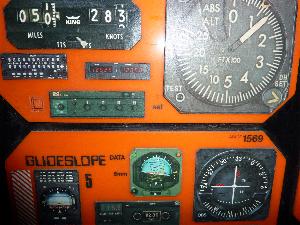
Also under the viewscreen is a panel marked with the Letraset title "Glideslope". A glideslope or glidepath (GP) antenna array is sited to one side of the runway and together with the localizer antenna array it provides information for the instrument landing system (ILS). This is displayed on a nav indicator such as the HSI and the attitude indicators that appear in the panel, helping the pilot to approach the runway on the correct course and rate of descent.
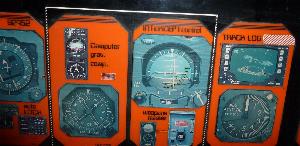
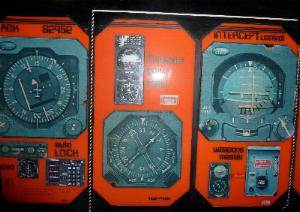
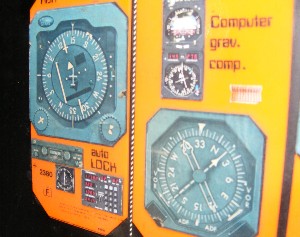
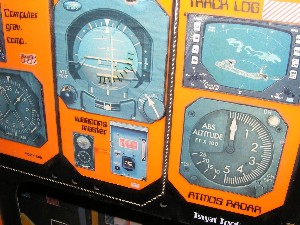
These instruments are at the top, over the viewscreen. There is a Sperry Stars horizontal situation indicator (HSI) showing the craft heading to 150 degrees. On the "Computer grav. comp." panel is a radio-magnetic indicator (RMI), showing the craft heading to 330 degrees, plus a small Course Deviation Indicator (CDI) and an attitude indicator (AI, also known as the artificial horizon).
On the "Weapons Master" panel is a large Sperry Stars attitude indicator with localizer and glidescope indicators, and a King KWX 50/60 Weather Radar System junction box (with large King switch and red Caution notice ("Refer to installation manual for details"). Under "Track Log" is another King weather radar, and below (with the caption "Atmos Radar") is an altimeter. This is a radio (radar) altimeter - which uses a radar signal to calculate the height of the craft from the ground (as opposed to a barometric altimeter, which uses air pressure).
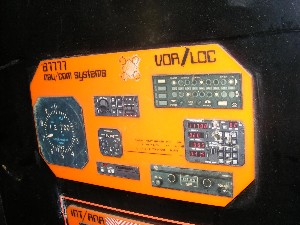
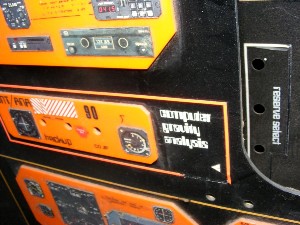
These instruments are on the left of the viewscreen. One panel is marked "NAV/COM SYSTEMS" and "VOR/LOC" in Letraset, which correctly identifies some of the controls. There is a Narco COM III TSO VHF transceiver and a Narco Master Avionics Control with headphone and speaker sockets. There is a King digital nav, which includes a VHF Omnidirectional Radio Range Localizer receiver (the VOR/LOC of the Letraset title). There is an altimeter, showing the craft is at 12,700 feet (38700m).
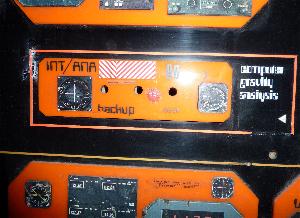
These instruments are on the lower left of the viewscreen. "Computer gravity analysis" has a CDI set to 330 degrees, North-North-West, and a small radar altimeter showing 0 height. The red and white chevrons are marked "Walkway Forward" and most strange is the small red triangle "Ejection Seat" with "Danger" written on each side.
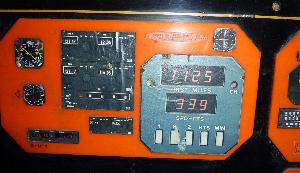
The panel below shows odd Letraset writing too: "Location for Wing Tip ---- Steadying trestle". This is a mark found on the exterior of an aircraft, showing where to place a supporting frame. It's likely this is Letraset marking from a model kit, perhaps a Submarine Spitfire which has this wording. The largest instruments is a King KDM 705A DME, showing speed- time to station (SPD-TTS) at 339, and distance at 112.5 miles.

On the bottom left is this panel, marked with the simple word "BOGUS", plus small text reading "Fuel DTD 230 Capacity 85 Gals". DTD 230 is the British Air Ministry "Director of Technical Development" specification 230, published in 1936, that specified 86 octane petrol. The capacity of 86 gallons (325.5 litres) is equivalent to a small Piper PA-32 Cherokee Six light aircraft.
Images copyright Martin Willey apart from Space 1999 images, copyright ITV Studios Global Entertainment
Page copyright Martin Willey